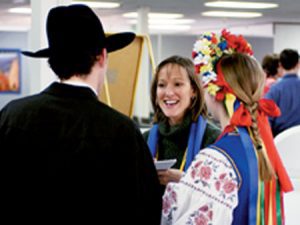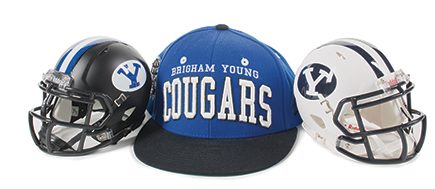
Two BYU folk dancers speak with a journalist during the 2002 Olympic Winter Games, Students, Faculty, and alumni all helped present BYU to the world.
By Carri P. Jenkins, ‘83
MONTHS before the 2002 Olympic Winter Games, a reporter with a prestigious East Coast magazine visited BYU and asked to talk with some of the university’s top religious scholars. From the interview it was clear that the journalist had trouble accepting that knowledgeable, respected professors could both believe and adopt the doctrines of the Church of Jesus Christ.
During the interview, Robert L. Millet, ’71, a professor of ancient scripture and a former dean of Religious Education, more than once acknowledged the reporter’s apprehension without the slightest hint of irritation. But, Millet said, the reporter could not ignore Christ’s own admonition that “ye shall know them by their fruits” (Matt. 7:16).
“Look at the fruit of this Church,” Millet challenged. “Look at the fruit of this university.”
Since that rainy afternoon, I have often thought about these words of the Savior: “Ye shall know them by their fruits.” For it seems that for the 60-plus national and international journalists who visited BYU during the Olympics, there was no better evidence of BYU‘s academic excellence and character than the simple fruit hanging from its vine.
Students, faculty and staff, and BYU‘s 354,000 alumni are the fruit of BYU. And they are the reason, we at University Communications quickly learned, that journalists were coming to BYU in the first place.
Five different Croatian news organizations came to report on the school of their beloved national hero Kresimir Cosic, a former BYU basketball star. Radiotelevizija Slovenia came for the same reason. Chinese Central Television, which provides national sports broadcasting for all of China, came to film a behind-the-scenes look at BYU‘s performing groups, so popular in their native land. Along the way, they were introduced to BYU‘s proficiency in languages and enthusiastically tackled that story as well. As a result, BYU was featured in 21 minutes of programming that has a potential audience of more than 1 billion.
Instead of using established public-affairs channels, the Canadian Broadcasting Company first contacted French professor Yvon R. Le Bras, ’72, with whom they already had an established connection. And because of their professional reputations, faculty such as French teaching professor Cinzia Donatelli Noble, ’78, English professor William G. Eggington, and visiting associate professor Markus Gappmaier all picked up the phone to hear reporters saying, “You don’t know me but . . .”
Because of BYU‘s reputation for athletic prowess, Boris Titov, Russia’s sports reporter of the year for 1999, covered a basketball game and asked for a full tour of the facilities where the athletes he had come to admire train.
In the end, so many calls came in to individual faculty and departments like Performance Scheduling, Athletic Media Relations, and the Museum of Art that University Communications issued a mass e-mail acquainting the campus community with our specially prepared press materials.
Admittedly, there were those rare occasions when members of the media simply stumbled upon us. Even then, it was not the glossy press kit—or even BYU‘s Olympic pin attached to it (hot as that item would become)—that drove their interest. It was, as Professor Millet promised, the students, the faculty, the staff, and the alumni—the fruit of BYU.
For instance, two weeks before the start of the Games, Fuji-TV of Japan was disappointed to learn that their scheduled appointment at the Olympic Village had fallen through. “Where you really need to go is BYU,” suggested their helpful taxi driver.
And so, on that recommendation—which may have come from a true BYU fan or someone interested in a large fare—they came to BYU, cameras and mikes in hand. Unfortunately, the student who had been lined up to talk with the reporters had to leave for class just as they arrived. This presented a problem as the crew had specifically asked to talk with a student who was volunteering for the Olympics. Anxious to find a replacement, Julie H. Walker, ’93, of University Communications asked a random student walking through the Museum of Art if he spoke Japanese and if he were an Olympic volunteer. The answer to both questions was yes. Daniel N. Woffinden, ’04, a sophomore linguistics major from Orange County, Calif., said that the journalists were initially skeptical of his Japanese skills and had a translator nearby. Such help was never needed, and the journalists praised Woffinden repeatedly for his excellent Japanese. Interestingly, Woffinden could have done the interview in Portuguese, which he also speaks fluently.
A week following the Fuji-TV visit, University Communications found itself in a similar situation. Voice of America’s Chinese branch was on campus preparing a story about BYU‘s performing groups and their impact on the people of China. Reporter Suli Yi, who recalled seeing the BYU Young Ambassadors in his native China when he was 10 years old, credited the Young Ambassadors and BYU‘s other touring groups with changing Chinese people’s perception of Americans during his youth. At BYU he and colleague Yiru Wang were able to meet with former members of the Young Ambassadors who had toured and performed in China in 1979.
Up until BYU‘s visit, Yi said, the Chinese people had never pictured Americans as being friendly, especially as a people who sang and danced. Christy Bates Kirkland, ’81, a member of that 1979 group, recalled for the Daily Herald, “We were the first Anglo people they had seen. When we went to the zoo . . ., the people were watching us more than they were looking at the animals.”
Before meeting with these former Young Ambassadors, however, Yi and Wang decided to cover the day’s devotional. At three minutes to 11, Li looked up into the audience of more than 10,000 students and said, “What I’d like right now is to talk with a Chinese student.”
Two members of the University Communications staff immediately split up, dashing up the steps of the Marriott Center. At the top, they communicated by cell phone, each admitting they had found no one. Then Kin-Yat Ken Shin, ’07, a 19-year-old student born in Hong Kong, walked through the doors. He was, in the reporter’s words, “perfect.”
It would be a word University Communications would hear over and over as reporters marveled not only at the advanced language capability of the students but at their ability to speak confidently and articulately into a camera—usually with no more notice than Shin was given. A popular anchor with Austria’s public television was so pleased with his interview with German-speaking BYU student Andrew P. Byrne, ’04, that he suggested, “You should use him again. He is perfect.”
It was Sonya Crawford of NBC 4 out of Los Angeles, however, who really captured the diversity of languages spoken at BYU. With the camera running in the Wilkinson Student Center’s Cougareat, she announced to the students that she wanted to conduct an experiment that would illustrate the breadth of languages spoken on campus. She then called out about 15 languages, including Swedish, Norwegian, Japanese, Korean, Chinese, and Russian and asked for the students to stand up if they spoke the corresponding language. When students stood to all of these languages, Crawford resorted to rarer languages. The only two languages that did not garner a response were Swahili and Czech. Turning to Grant R. Madsen, ’98, of University Communications at the end of her exercise, she simply said, “That’s cool.”
A bit unexpected was that journalists also thought BYU students’ adherence to the honor code was cool. Peter Hossli of Facts magazine in Switzerland reported on a party he attended with BYU student Justin Smith, ’02, where the students were having a great time, all while sipping strawberry-kiwi lemonade.
The Los Angeles Times quoted BYU student Julie Harris, ’02, as saying, “The code reflects who we are in the first place. It’s empowering, not restricting.”
David Lamb, who wrote the L.A. Times story, got to know Julie, a returned missionary who served in Venezuela, and Chaliese Wouden, ’01, a returned missionary who served in Romania and speaks three languages, while visiting with them in BYU‘s Media Center. Initially, he had only wanted to ask a few questions over the phone. Once he arrived on campus, however, his list of questions lengthened.
Lamb concluded his visit to BYU by saying to Michael D. Smart, ’97, of University Communications: “This has to be one of the most cosmopolitan universities in the nation.”
A week later in an article accompanied by three pictures of BYU students, Lamb declared in his lead, “It’s time to quit poking fun at Provo.” The article goes on to explain why, especially noting the positive influence of BYU‘s “clean-cut enrollment, [which] comes from 50 states and 110 countries.”
He also pointed out that “most [BYU] undergraduates have spent up to two years on a Mormon mission. More than 43 percent of the American students have lived abroad and 70 percent are fluent in a second language.” (To read the Los Angeles Times article in its entirety, see byu.edu/news/latimes/latimes.htm.)
For many reporters, these statistics were astounding. However, after a few hours on campus, they no longer questioned their validity. Often arriving with little advanced notice, reporters were usually taken aback at the number of students and faculty who spoke their language and at their fluency.
Without the assistance of many students and faculty, however, such proof would never have been possible. Professors and administrators dropped everything to work with reporters. Many others spent hours preparing for press conferences at the Utah Media Center.
Then there were the faculty who welcomed the media into their classrooms, and the students—from those in performing groups to those in the Foreign Language Student Residences to those plucked off the sidewalks—who spoke with the press.
Looking back, it is not surprising that the reaction most journalists had to BYU—and the subsequent coverage—was overwhelmingly positive. As Ken Shin, who spoke with the Chinese reporters, told them, “This is a remarkable place to go to school. Remarkable people come here to study.”
Carri P. Jenkins, assistant to the president for University Communications, directed BYU‘s publicity efforts during the 2002 Olympic Winter Games.









